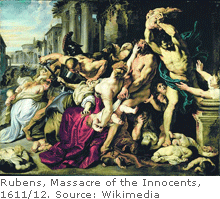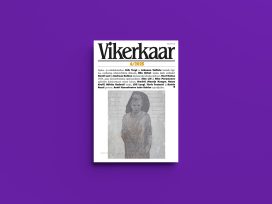Around the world, commonplace barbarisms of the past – human sacrifice, slavery, cannibalism, stoning and lynching – are going out of fashion, if they are still practiced at all. Across the western world tolerance of the tormenting of minorities has declined in recent decades, along with corporal punishment in schools, the slapping of children by their guardians, football hooliganism and cruelty to animals. The US, a nation whose cities had become notorious for murders and muggings in the 1980s, has witnessed a sustained collapse in violent crime over more than twenty years. Europe, a continent that has known its share of war, has enjoyed an unprecedented peace for seven decades among its democratic states. On this island, a violent and once seemingly intractable conflict which raged for decades is over for all but a handful of ultra-extreme diehards.
 Are these merely unrelated random events and happenings that mean nothing when taken together, or do they form part of a pattern? If the latter, could they amount to evidence of a trend towards a change as enormous in its significance as the pacification of human affairs? Propose such a thesis to knowledgeable and informed people and reactions mostly range from eyebrow-raising scepticism to derisory snorting. Conventional wisdom has it that violence is at least as prevalent today as it has ever been, and more people believe the world is going to hell in a handbasket than think it is becoming more peaceful and secure.
Are these merely unrelated random events and happenings that mean nothing when taken together, or do they form part of a pattern? If the latter, could they amount to evidence of a trend towards a change as enormous in its significance as the pacification of human affairs? Propose such a thesis to knowledgeable and informed people and reactions mostly range from eyebrow-raising scepticism to derisory snorting. Conventional wisdom has it that violence is at least as prevalent today as it has ever been, and more people believe the world is going to hell in a handbasket than think it is becoming more peaceful and secure.
At no time in the recent past was such pessimism as much in evidence as in the late 1990s, when stock was being taken of the twentieth century. It was common then to read and hear inventories of the horrors of the previous hundred years: the brutal subjugation of native peoples in Europe’s violently won colonies from Congo to Indochina; the First World War’s industrial-scale bloodletting from Flanders to Gallipoli; and the barbarity of mid-century totalitarians Hitler, Mao and Stalin whose victims numbered in the tens of millions. And then there are those countries and regions whose very names became by-words for mass killing and genocide in more recent times Cambodia, Rwanda, the Balkans, Congo and Darfur. This, surely, is all the evidence one needs to dismiss any notion of progress towards a more peaceful world.
But it isn’t. The vast and rapidly multiplying body of highly granular evidence about the past shows incontrovertibly that the chances of an inhabitant of this planet dying violently – on the end of the sword of a besieging soldier, on the battlefield, for reasons of religious belief or ethnic background, by stabbing or shooting in a city street or for virtually any other reason – have never been lower. In Ireland today, as in most of the rest of western Europe, one person in 100 000 dies violently at the hand of another in any given year, a mere fraction of the figure for any other age. And it is not only the prevalence of killing that has declined but that of almost all forms of violence. The accumulating body of hard evidence on the decline of violence in human history has been slow to seep into popular consciousness (the reasons are discussed below), but it is happening. Two recently published books one by Steven Pinker, a Harvard psychologist and polymath, another by Robert Muchembled,a French historian, should do much to bring the good news to a wider audience. Both authors collate vast quantities of data from a range of disciplines, synthesize the findings and present them in a manner that is (mostly) accessible to the lay reader. They have done a great service in explaining the world as it is and as it has been, and refuting the belief that man is incapable of progress and that his destiny is an ineluctable “war of all against all”.
In August last year, the body of a woman was taken from a bog outside Portlaoise. It quickly became evident that she had died thousands of years earlier, and like many if not most iron age “bog bodies” found on this island, she did not die peacefully, but bore signs of having met a violent end. The same is true of thousands of bog bodies taken from the flesh-preserving peat of northern Europe, and of “Ötzi”, another iron age victim of violence, whose body in 1991 was spewed from the same glacier on today’s Swiss-Italian border into which it had been cast five millennia ago.
Human remains from iron age Europe form only a tiny fraction of the picture that has emerged about violence in the distant past. For decades forensic archaeologists have been finding out how the ancients they dig up met their end. By first examining the bodies of those they exhume to determine cause of death and then calculating the number of inhabitants in a settlement, they can arrive at estimates of violent death rates. From the study of settlements around the world a pattern has become universally clear violent death was most common in societies based on hunting, gathering and basic horticulture, a finding anthropologists corroborate from their observations of the planet’s remaining groups of hunter-gatherers.
The move from foraging bands and tribes to agriculture-dependent societies with proto-states resulted in a fivefold decline in violent death rates, according to Pinker’s survey of dozens of studies of individual societies. Although rulers over these larger and more complex societies more often than not became agents of death themselves, the order they brought even if despotic and unjust led to less violence than in the anarchical worlds that predated them, in which the only law was that of the jungle. Most importantly, this new order curbed the kind of raiding parties, described so vividly in the Táin Bó Cúailnge (the cattle raid of Cooley) and many of the world’s other mythologies, which accounted for most of the killing in less complex societies.
If the move from foraging to farming caused a big decline in killing, a much sharper (thirtyfold) collapse took place with the advent of what German sociologist Norbert Elias called the “civilizing process”, which both Muchembled and Pinker agree was a seminal contribution to understanding how human affairs have become less violent over time. In his book of the same name, Elias, drawing on contemporaneous accounts of life in medieval and early modern Europe, observed a series of changes. A culture of honour, in which violence would erupt for even trivial slights, gave way to a culture of dignity, which prized self-restraint. This manifested itself in the gradual disappearance of duelling among the nobility, the phased outlawing of the carrying of weapons, the introduction of penalties for violent behaviour (including the ultimate penalty) and more comprehensive law enforcement. Much of this trend was helped along and sometimes driven by the expansion of state power, including Leviathan’s gradual acquisition for itself of a monopoly on the legitimate use of violence. Elias also believed (and Muchembled and Pinker agree) that the emergence of the merchant middle classes, who wanted peace to pursue profit, tempered the influence of the violence-obsessed aristocratic warrior class. The result was the waxing of positive sum commercial values and the waning of winner-takes-all martial values.
Elias’s thesis, first put forward in 1939, was largely ignored for decades because of the timing of its publication. As Europe was plunging into its worst ever conflict talk of a “civilizing process” seemed preposterous. The Cold War and the threat of humankind being wiped out by nuclear war further discredited theories of history which posited progress and directionality in human affairs. But with the rise and rise of the university, and the huge expansion in the numbers engaged in scholarship, ever more detailed evidence of how previous generations lived has been accumulated. It was studies on homicide rates in Europe which form the backbone of Muchembled’s book and one of many supports for Pinker’s much more ambitious work that brought the aging Elias recognition late in life. Painstaking trawls through death certificates or equivalent records, which have been kept in some parts of Europe for almost a millennium, by criminologists and historians allowed murder rates to be estimated over hundreds of years. In every case where records exist, the murder rate has been in free fall century after century. It was when these studies began to emerge in the 1970s and later that the hard evidence emerged to show that a “civilizing process” did in fact take place as Elias has suggested.
Elias, in his civilizing process, and Muchembled in his recent work, deal with interpersonal violence within states. They have little or nothing to say about other forms of violence, most notably violence between and among states. But Pinker does, and in some depth in his eight-hundred-page book, in which he leaves almost no potential challenge to his thesis of a pacifying world unaddressed. And there is very good reason to address the question of war given that while Leviathan’s writ ran more evenly and deeply across territories over which it was sovereign, thereby lessening violence within states, its rise and rise also led conflicts between states to become bigger, bloodier and longer.
Warfare between modern states is very different from the warring of feudal societies, in which battle was conducted largely by the aristocratic warrior class as a way of life. If it was endemic, it was usually short and contained, or what today might be called low and medium intensity warfare. Just as in corners of the world where warlordism persists, such as Afghanistan, fighting usually took place in the summer months and did not involve, for the most part, the lower orders. All that changed as states expanded their warmaking capacities for both defensive and offensive purposes establishing, among others things, standing armies to replace the motley collection of knights, mercenaries and footsoldiers that had previously been assembled for conflicts. The culmination of these developments was “total war” in the twentieth century, when industrialization and advances in military technology brought almost everyone in societies involved in conflict to contribute to the “war effort”.
This conventional and not incorrect depiction of the history of warfare might at first glance appear to refute the pacification thesis. But it does not, for two reasons. First, the twentieth century may have been the bloodiest century in absolute terms, but prevalence of violence or anything else is not about absolute numbers but about percentages and proportions. Second, there has been a spectacular decline in interstate conflict in both numbers of wars and lives lost since the last total war ended in 1945.
First take the issue of absolutes. World War II was the bloodiest conflict in history, with fifty-five million casualties. This was a cataclysm to be sure, but when its victims are measured as a proportion of the people alive on the planet, it was the ninth bloodiest event in known history according to Mathew White, an “atrocitologist” cited by Pinker. He finds that all the other eight more bloody happenings took place before the twentieth century. The worst, according to these estimates, happened in eighth century China, when thirty-six million people lost their lives in the An Lushan revolt. If the same proportion of the planet’s population had died in World War II, according to White, the body count would have reached a staggering 429 million. Taking a more local example, Cromwell’s slaughter of Drogheda’s defenders and inhabitants in 1649 led to as many deaths in twenty-four hours as during the entire span of the twentieth century’s Troubles. But the population of the island in the mid-seventeenth century was estimated at around one million. If correct, that day in Drogheda resulted in five or six times more violent death as a portion of the population than did three decades of the recent Troubles.
To illustrate the point in another way, more than a million people die on the world’s roads every year, and the number is rising fast. A century ago, so few people were killed in motoring accidents that worldwide figures are unsurprisingly unavailable. What is the greatest cause of more deaths in car accidents over that time? The answer is of course more cars. And just as more cars lead to more car accidents, more people lead to more violence as the world’s population has exploded over the past two centuries (man is a violent species, something neither the authors of the books under review nor the reviewer contest). But just as man can learn to drive more safely (as Irish road fatality figures attest), so also has he the capacity to learn how to manage more peacefully the inevitable disagreements and conflicts that arise when humans interact. And that is what has happened.
The second substantial plank of evidence supporting the pacification thesis as it applies to interstate conflict is its spectacular decline since 1945, and this despite the number of states in existence increasing fourfold since that time. The decline in the incidence of war and casualties is so well documented that it is not contested among students of international relations or related disciplines and need not be detailed here (the evidence amassed by the Peace Research Institute Oslo is but one source of hard data and can be found at www.prio.no/Data/).
What is subject to considerable debate, however, is why wars happen less frequently. Explanations abound. Democratization is one. People don’t vote for wars and vote out governments who get bogged down in them. Closely related to democratization is feminization: opinion polls almost always show women to be less supportive of military solutions to conflicts. The emergence of international organizations most importantly the United Nations and the rule of international law are another. Collective security structures as they exist today are far from perfect, but they do make a difference. So does the deployment of peacekeepers in the world’s trouble spots, a point Pinker stresses and believes needs to be stressed in order to avoid the nothing-can-be-done fatalism which exists partly because of the existence of the misplaced view that violence is not on the wane.
Along with these multiple political explanations, changing economic dynamics have changed the cost/benefit calculus of going to war. Once, seizing territory was believed to be a route to riches. Today, prosperity is generated by investment in knowledge economies, not extracted on the point of a bayonet. Besides, why invade a country to gain access to its resources when they can be bought and shipped peacefully on open international markets? And as the gains from war have declined, the costs of waging it and of occupation of a conquered territory have increased. When the Romans marched into new territories, insurgency was almost impossible. To kill a legionary required getting close enough to him to use a sword or a spear. Today the Kalashnikov, rocket-propelled grenade and improvised explosive device have made warfare asymmetrical a small number of determined people can take on the most powerful armies, as has been demonstrated time and again from south Armagh to Helmand province. Moreover, conflicts in a world of high tech militaries can escalate to total war, and ultimately, in cases where states have nuclear capabilities, mutually assured destruction.
If the decline of violence in human affairs is so marked, then why is it so underappreciated? Three reasons stand out. The first is the sheer volume of new information emerging about the past. The sum of human knowledge is growing at an ever increasing rate. That is true of almost every area and certainly true of our understanding of the past, as the sheer numbers of people around the world engaged in full time scholarship has multiplied. Whereas, for example, a hundred years ago, archaeology as a discipline hardly existed, now tens of thousands of people around the world devote their working lives to excavating the past. With so many people involved in ever more specialized study it becomes ever more difficult for experts to keep abreast of developments in their own areas, never mind remaining knowledgeable about new research from other relevant fields. The deepening “siloisation” of scholarship works against broad syntheses and slows the emergence of research findings into the public domain. The importance of the work of Muchembled and Pinker is mainly that they take a bird’s eye view of the material, join the dots and describe the bigger picture trends.
A second reason good news is unappreciated is because what does not happen usually goes unremarked upon, while what does happen – such as an outbreak of violence somewhere on the planet – more easily grabs the attention, regardless of its importance in the broader sweep of history. On a planet of more than seven billion people, a rapidly growing proportion of which has the means to communicate instantly, there is no shortage of violence reported on in the media, tweeted on by those involved and uploaded from smartphones.
According to commonly cited media reports, fewer than 10,000 have died in Syria since the uprising there began a year ago (out of a population of twenty million people). It is not to lessen in any way the import of those deaths, but they amount to a fraction of the numbers killed in a single day when cities in that region fell in biblical and medieval times, or indeed anywhere else for which historical records or estimates of any kind exist pre-Raj India, Shogunate Japan or pre-Colombian America.
Another reason that the decline of violence has not permeated popular or even elite consciousness is the debt we owe to the most influential social theorists of the past, whose speculations on human nature continue to inform opinion. Thomas Hobbes and Jean Jacques Rousseau who believed, respectively, that man’s natural state was of “war of all against all” and that violence was caused by the corrupting influence of societal constructs which turned “noble savages” into vicious killers. Pinker, never one to show deference to anyone, is dismissive of the two most influential philosophers of war and peace. Both men wrote long before anyone had seriously studied such societies, leading Pinker to conclude: “Hobbes and Rousseau were talking through their hats: neither knew a thing about life before civilization.”
Is violence innate or learned? Muchembled feels unqualified, as an historian, to arrive at a definitive answer, but Pinker does. As a psychologist and leading proponent of evolutionary biology, he has a great to say on the matter. The standard explanation of the human brain and mind today is that they evolved to their present form over hundreds of thousands of years in Africa when the species practiced a hunter-gatherer existence. Over that time capacities evolved to cooperate harmoniously and compete violently as man adapted to life on the savannah. Pinker finds no evidence to suggest that man’s genetic make-up has evolved to make him less aggressive in more recent times as we have adapted to a non-hunter-gatherer environment, but behaviour has clearly changed. Changing environments have lessened – by many means – the gains from violent competition and placed a premium on man’s co-operative side. Pinker sees four “better angels of our nature”, a term borrowed from Abraham Lincoln, as the sources of progress: a moral sense, reason, self-control and empathy. All of these traits counteract our “inner demons” – the innate capacities for sadism, dominance and revenge – which we also evolved as we adapted to life on the savannah.
Although he does not overemphasize empathy (the word was coined a mere century ago), the capacity and willingness to see things from the perspective of others has profoundly changed our attitudes towards violence. For most people today to witness another human being torn apart by wild animals, impaled, hung, drawn and quartered or guillotined would be a trauma. Yet our forebears seem to have considered such sights entertaining spectacles and diverting curiosities. That we feel the pain of strangers from different countries and cultures and sometimes dig deep in our pockets to help them via a network of charitable organizations shows how much out attitudes to “the other” have changed.
Pinker believes this has much to do with increasing literacy – reading profoundly deepens the understanding of the perspective of others – and attributes to this the “humanitarian revolution” of the seventeenth and eighteenth centuries which saw the first campaigns against cruelties such as torture and slavery. Television may have caused another significant widening of the circle of empathy, reflected in the coining of the term “the global village”. In the 1940s Americans celebrated dropping an atomic bomb on Japan; two decades later they protested at the actions of their military in Vietnam. Despite the humiliation suffered by the US in that war and the consequences of defeat for its prosecution of the Cold War globally, no threat was ever made to deploy nuclear weapons in that conflict. Coverage of the war provided some of the most enduring images in television history. The restraint exercised in warfare has become greater over subsequent decades. The high altitude indiscriminate bombing of northern Vietnam and Cambodia has been replaced by precision bombing in subsequent conflicts, such as the Iraq wars, when Americans went out of their way to avoid civilian casualties and stressed that military action was not against the people of Iraq but against its leader and his armed forces.
None of this is to suggest that utopia is at hand. Neither author argues that the world has – or ever will – eliminate violence, and there is always a danger the trends which have led to its decline could go into reverse. Muchembled’s Franco-centric concern is of a possible decivilizing process taking place in the banlieues, as gang culture leads to a reversal of the self-restraint that in the past caused violence among young men to decline. Pinker too sees the potential for reversals and is careful not to give hostages to fortune by suggesting that the pacifying trend is unalterably unidirectional. But the trends up to now are undeniable. If it seems curious that the most positive development in human affairs since man started walking upright appears to have passed most people by, Pinker and Muchembled have done a great deal to change that.







